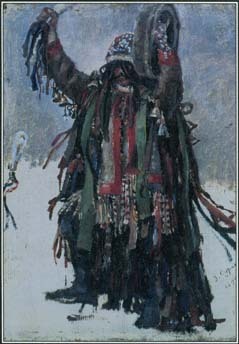 Submitted by Mojo on
Submitted by Mojo on

Among the Siberian and Mongolian indigenous peoples, the universe is conceived as a living organism. The polar star is a celestial nail, and the Altaic shamans decorate their drums with the symbols of Venus and the constellation of the Great Bear. In Buryat shamanistic symbolism, the World-Tree is connected to the World-River, which interlinks with all the three worlds. It must be traversed by the shaman in order to reach any part of the Otherworld.
In Siberian cosmology, the universe is also associated with animal concepts, such as the elk for the Middleworld, the bear for the Master of the Animals, or, among the Evenks, for the ethnogenic father. In addition, the universe has a tripartite structure consisting of the Upper, Middle, and Lower worlds, each one being a replica (imago mundi) of the other two. The Yakut shaman embarks on a soul journey by ascending progressively several celestial poles, the World-Tree. It is particularly important that the drum of a Siberian shaman be made from the wood of the World-Tree. The cosmological symbolism depicted on the drumskin, in conjunction with the whole drum, stands for the entire universe. All these types of symbolic devises are internalized by the shaman as his or her personal metaphors.
"Shamans are at once doctors, priests, social workers and mystics. They have been called madmen or madwomen, were frequently persecuted throughout history, dismissed in the 1960s as a «desiccated» and «insipid» figment of the anthropologist's imagination, and are now so fashionable that they inspire both intense academic debate and the naming of pop groups. Shamans have probably attracted more diverse and conflicting opinions than any other kind of spiritual specialists. The shaman seems to be all things to all people.
"The word «shaman» comes from the language of the Evenk, a small Tungus-speaking group of hunters and
reindeer herders in Siberia. It was first used only to designate a religious specialist from this region. By the beginning of the 20th century it was already being applied in North America to a wide range of medicine-men and medicine-women, while some New Age practitioners today use the word widely for persons who are thought to be in any sort of contact with spirits.
"The Siberian shaman's soul is said to be able to leave the body and travel to other parts of the cosmos, particularly to an upper world in the sky and a lower world underground. This ability is traditionally found in some parts of the world and not in others and allows us to speak of clearly shamanistic societies and cultures. A broader definition than this would include any kind of person who is in control of his or her state of trance, even if this does not involve a soul journey, as in Korea. In these senses, shamans are quite different from other kinds of spirit medium who are possessed and dominated by spirits as and when the spirits themselves choose and who then need to be exorcized. But even though the shaman enters the trance under controlled conditions, his or her «mastery» of the spirits remains highly precarious. The shaman's profession is considered psychically very dangerous and there is a constant risk of insanity or death.
"There can be no shaman without a surrounding society and culture. Shamanism is not a single, unified religion but a cross-cultural form of religious sensibility and practice. In all societies known to us today shamanic ideas generally form only one strand among the doctrines and authority structures of other regions, ideologies and practices. There were probably purely shamanist communities in the past but we have only vague ideas about what it must have felt like to live in them. Shamanism is scattered and fragmented and should perhaps not be called an «-ism» at all. There is no doctrine, no world shamanic church, no holy book as a point of reference, no priests with the authority to tell us what is and what is not correct.
"Nevertheless, there are astonishing similarities, which are not easy to explain, between shamanic ideas and practices as far as the Arctic, Amazonia and Borneo, even though these societies have probably never had any contact with each other. Many current interpretations emphasize the healing side of shamanism, but this is only one aspect of the shaman's work. Among other things, shamanism is a hunter's religion, concerned with the necessity of taking life in order to live oneself. The shamanic view of cosmic equilibrium founded largely on the idea of paying for the souls of the animals one needs to eat, and in the societies the shaman flies to the owner of the animals in order to negotiate the price".
Excerpted from: P. Vitebsky. The Shaman. London: MacMillan, Duncan Baird Publishers, 1995